Destruction Is All We Have to Show for a 15-Year War in Afghanistan
Since 2001, the U.S. has spent more than $103 billion on the Asian country—more than it spent on the entire European continent after World War II. And there is no end in sight for the debacle that George W. Bush began and Barack Obama continued.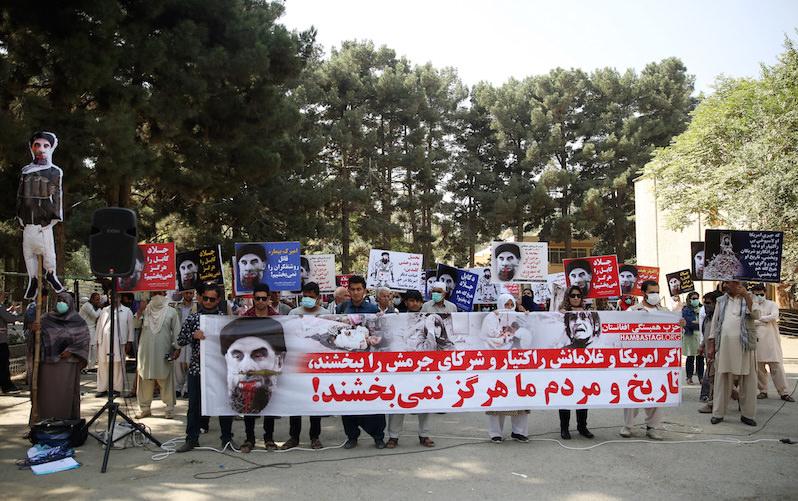
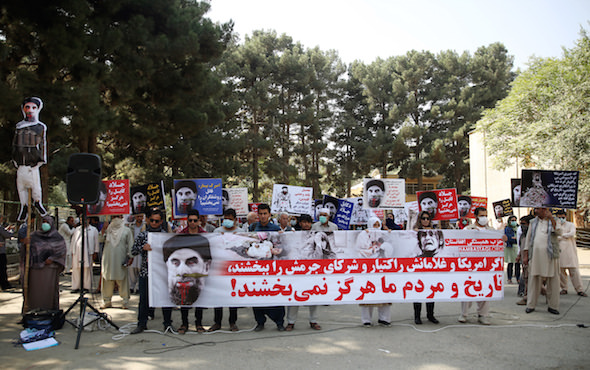
A protest against former Prime Minister Gulbuddin Hekmatyar in Afghanistan. (Massoud Hossaini / AP)
The longest war in United States history has warranted barely any mentions during the presidential or vice presidential debates. Afghanistan was discussed once in passing during each event, even though the U.S. has spent hundreds of billions of dollars on the nation over 15 years and it is unraveling faster than ever.
Since its beginning, the Afghanistan war was the forgotten stepsister of the Iraq War. Shellshocked by the 9/11 attacks, liberals gave President George W. Bush a pass when he launched the first airstrikes on Oct. 7, 2001, and bought himself time to build a case for a war in Iraq—the more desirable target to him. Millions around the world marched against the Iraq War in early 2003, incensed about the clearly manufactured evidence of “weapons of mass destruction.” Far fewer activists felt the same moral outrage over Afghanistan’s misery, as if the entire country was to blame for the sins of al-Qaida. That double standard was reflected in Barack Obama’s 2008 presidential bid when he promised to ramp down the Iraq War while expanding the Afghan war. From the start, Afghanistan suffered from what my co-author James Ingalls and I called “the propaganda of silence” in our 2006 book, “Bleeding Afghanistan.”
Over nearly the entire four terms combined of Bush and Obama, the U.S. has pummeled Afghanistan with air fire. Bombing of civilians continues today. A U.S. airstrike on Sept. 28, reportedly intended for Islamic State militants, resulted in the deaths of 15 civilians who had gathered to greet a returning elder from his Saudi Arabian pilgrimage to Hajj. Reflexively, U.S. officials, as has been the practice from the start of the war, offered to investigate the matter. While U.S. ground troops have been reduced to a few thousand today, down from tens of thousands, the appearance of Islamic State in Afghanistan has put any ideas of troop withdrawal on hold.
Fifteen years into the Afghanistan war, women remain insecure and targeted by fundamentalist violence. Afghan women’s rights provided a convenient justification for the launch of the war. Along with retribution for 9/11, Americans hoped to enjoy the satisfaction of freeing Afghan women from the clutches of the evil, misogynist Taliban. The only problem is that women’s rights do not materialize from war, and Afghanistan was no exception. Just as the U.S. installed fundamentalist warlords in Afghanistan in the 1970s and ’80s as part of its proxy war with the Soviet Union, it re-empowered many of the same men, widely considered war criminals, in its fight against the Taliban. Today, under Taliban-controlled areas, women suffer.
And almost everywhere else in Afghanistan, women also suffer. Amnesty International reported that 4,000 cases of violence against women were reported in the past nine months, and acknowledged that such incidents are severely underreported. Last December, a horrific case emerged of a mob of men beating a woman named Farkhunda Malikzada to death in broad daylight after falsely accusing her of burning a Koran.
Fifteen years into the Afghanistan war, the Taliban remains active, working feverishly to retake the country, of which they controlled 90 percent in 2001. Now, Afghan National Army forces backed by the U.S. are fighting to push out Taliban forces from the key northern city of Kunduz, a major battlefield in 2001 between the Taliban and the Northern Alliance warlords. After being driven out of much of the country in 2001, the Taliban is now stronger than ever and has retaken more land than at any other point during the war. The United Nations recorded nearly 3,500 civilian deaths in 2015, a record high. A majority of those deaths were at the hands of the Taliban, a group of militants the U.S. has spent 15 years fighting.
The non-Taliban warlords in Afghanistan also remain strong today, and none of them have been brought to justice for their past crimes. In fact, many have been rewarded with political office such as Chief Executive Abdullah Abdullah and Vice President Abdul Rashid Dostum, who both have notoriously violent pasts. The most audacious example is former Prime Minister Gulbuddin Hekmatyar, whose mass crimes have been rewarded with government-funded security and legal immunity through a widely hailed “peace deal” signed just weeks ago. Hekmatyar, once known as the “Butcher of Kabul,” received a whopping $600 million from the U.S. during the Soviet occupation of Afghanistan and was, according to historian and U.S. foreign policy critic William Blum, known to the CIA and U.S. State Department officials as “scary,” “vicious,” “a fascist” and “definite dictatorship material.” He once fought the Soviets for the U.S., then fought the U.S. for the Soviets. He also fought against his fellow warlords, joined the Taliban and then fought against the Taliban. As part of its deal, the U.S.-backed Afghan government, which has promised to press for an end to sanctions against him, will allow Hekmatyar to “re-establish himself in the capital and join the political process,” with the promise of an “honorary post” in the government. In 2003, the State Department named Hekmatyar a “Specially Designated Global Terrorist.”
Today, Secretary of State John Kerry has given his blessing to the “peace deal,” implying that it could be a model for dealing with other war criminals and the Taliban.
Fifteen years into the Afghanistan war, the U.S. has spent record amounts of money with little to show for it. In fact, the U.S. has spent more money on Afghanistan than it did on the entire European continent after World War II. In current dollars, the U.S. spent $103 billion on 16 European nations over four years as part of its Marshall Plan. U.S. expenditures in Afghanistan have now exceeded that amount. Of that amount, ProPublica, in an investigative report, found that at least $17 billion was simply wasted, citing “bad decisions, bad purchases and bad programs” on the part of the U.S. government. Military contractors, like Afghan trucking-company owner Hikmatullah Shadman, became spectacularly rich. The latest report of the Special Inspector General for Afghanistan Reconstruction (SIGAR) admitted that “the United States partnered with warlords and their militias,” and “[w]hen these strongmen and other elites gained positions of power in the Afghan government, they often engaged in rampantly corrupt activities.” According to the SIGAR report, “the U.S. government also failed to recognize that billions of dollars injected into a small, underdeveloped country, with limited oversight and strong pressures to spend, contributed to the growth of corruption.” Some of the money has even ended up in the hands of the Taliban. We can rest assured that ordinary Afghans have been last among the beneficiaries of U.S. largesse.
As its longest war continues with no end in sight, what does the U.S. have to show for it? In many ways Afghanistan is depressingly right back where it started 15 years ago, a time when it was already a war-weary nation. Warlords and fundamentalist militants once more rule the country and fight one another while the West continues its ground and air operations. Ordinary Afghans remain repressed and tragically impoverished. Perhaps mention of the war has remained elusive during this presidential election race simply because both major parties are equally to blame for the debacle that Bush began and Obama continued.
Maybe there is a silent agreement to not expose the truth of the decade and a half of devastation we have wrought on a poor nation. As the Afghan hero and women’s rights activist Malalai Joya once said, “This endless U.S.-led war on terror … is in fact a war against the Afghan people.” Perhaps that is the shameful admission that we cannot bring ourselves to utter.
Independent journalism is under threat and overshadowed by heavily funded mainstream media.
You can help level the playing field. Become a member.
Your tax-deductible contribution keeps us digging beneath the headlines to give you thought-provoking, investigative reporting and analysis that unearths what's really happening- without compromise.
Give today to support our courageous, independent journalists.


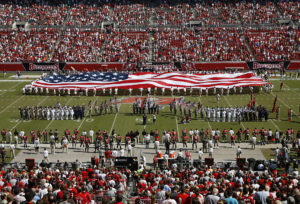
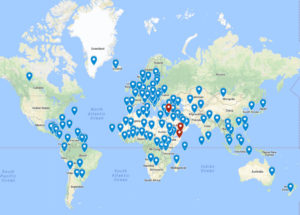
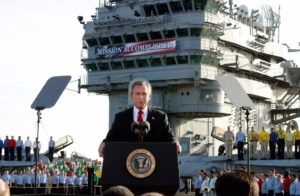
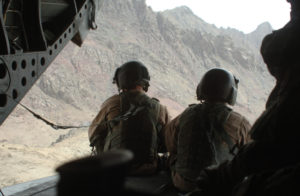
You need to be a supporter to comment.
There are currently no responses to this article.
Be the first to respond.